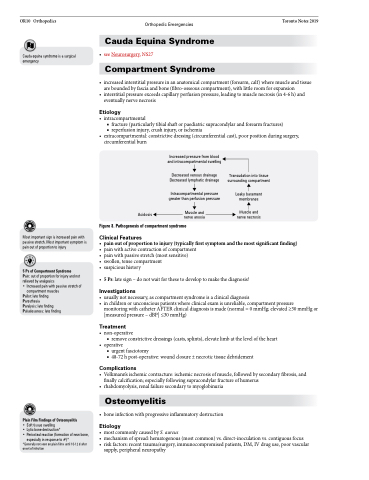Page 944 - TNFlipTest
P. 944
OR10 Orthopedics
Orthopedic Emergencies
Toronto Notes 2019
Cauda equina syndrome is a surgical emergency
Cauda Equina Syndrome
• seeNeurosurgery,NS27 Compartment Syndrome
• increasedinterstitialpressureinananatomicalcompartment(forearm,calf)wheremuscleandtissue are bounded by fascia and bone (fibro-osseous compartment), with little room for expansion
• interstitialpressureexceedscapillaryperfusionpressure,leadingtomusclenecrosis(in4-6h)and eventually nerve necrosis
Etiology
• intracompartmental
■ fracture (particularly tibial shaft or paediatric supracondylar and forearm fractures) ■ reperfusion injury, crush injury, or ischemia
• extracompartmental:constrictivedressing(circumferentialcast),poorpositionduringsurgery, circumferential burn
Acidosis
Increased pressure from blood and intracompartmental swelling
Decreased venous drainage Decreased lymphatic drainage
Intracompartmental pressure greater than perfusion pressure
Muscle and nerve anoxia
Transudation into tissue surrounding compartment
Leaky basement membranes
Muscle and nerve necrosis
Most important sign is increased pain with passive stretch. Most important symptom is pain out of proportion to injury
5 Ps of Compartment Syndrome
Pain: out of proportion for injury and not relieved by analgesics
• Increased pain with passive stretch of
compartment muscles Pallor: late finding Paresthesia
Paralysis: late finding Pulselessness: late finding
Figure 8. Pathogenesis of compartment syndrome
Clinical Features
Plain Film Findings of Osteomyelitis
• Soft tissue swelling
• Lytic bone destruction*
• Periosteal reaction (formation of new bone,
especially in response to #)*
*Generally not seen on plain films until 10-12 d after onset of infection
• painoutofproportiontoinjury(typicallyfirstsymptomandthemostsignificantfinding)
• painwithactivecontractionofcompartment • painwithpassivestretch(mostsensitive)
• swollen,tensecompartment
• suspicioushistory
• 5Ps:latesign–donotwaitforthesetodeveloptomakethediagnosis!
Investigations
• usuallynotnecessary,ascompartmentsyndromeisaclinicaldiagnosis
• inchildrenorunconsciouspatientswhereclinicalexamisunreliable,compartmentpressure
monitoring with catheter AFTER clinical diagnosis is made (normal = 0 mmHg; elevated ≥30 mmHg or [measured pressure – dBP] ≤30 mmHg)
Treatment
• non-operative
■ remove constrictive dressings (casts, splints), elevate limb at the level of the heart
• operative
■ urgent fasciotomy
■ 48-72 h post-operative: wound closure ± necrotic tissue debridement
Complications
• Volkmann’sischemiccontracture:ischemicnecrosisofmuscle,followedbysecondaryfibrosis,and finally calcification; especially following supracondylar fracture of humerus
• rhabdomyolysis,renalfailuresecondarytomyoglobinuria
Osteomyelitis
• boneinfectionwithprogressiveinflammatorydestruction
Etiology
• mostcommonlycausedbyS.aureus
• mechanismofspread:hematogenous(mostcommon)vs.direct-inoculationvs.contiguousfocus
• risk factors: recent trauma/surgery, immunocompromised patients, DM, IV drug use, poor vascular
supply, peripheral neuropathy


